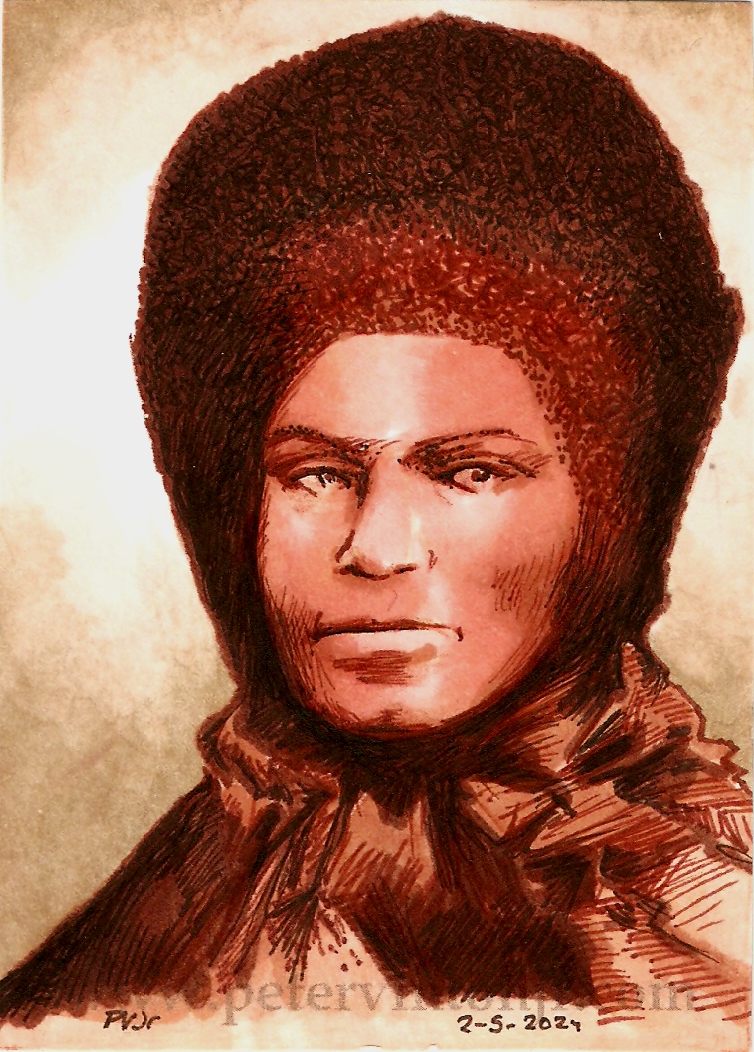Lesson 141:
Lissete Denison Forth
An ongoing illustrative history study
This piece originally posted 2/5/2024
 Lissete Denison Forth was born enslaved sometime in 1786, in Detroit in the then-unincorporated Northwest Territories. Forth was unfortunately born three years shy of the adoption of the Northwest Ordinance, which prohibited slavery in what would ultimately become Michigan. In 1805, Lisette's parents, Peter and Hannah Denison, were freed upon the death of their owner --but Lisette and her five siblings were transferred to the ownership of that owner's brother. Peter and Hannah were encouraged to sue for their children's freedom and while the territorial courts ultimately ruled only in favor of the four Denison siblings that had been born after 1789, it further asserted that the unincorporated territories were under no obligation to honor the tenets of the Fugitive Slave Law (see Lesson #123 in this series). Following the letter of this ruling, Lisette and her older brother coincidentally crossed into Canada and established residency there, returning to Detroit as immigrants in 1815.
Lissete Denison Forth was born enslaved sometime in 1786, in Detroit in the then-unincorporated Northwest Territories. Forth was unfortunately born three years shy of the adoption of the Northwest Ordinance, which prohibited slavery in what would ultimately become Michigan. In 1805, Lisette's parents, Peter and Hannah Denison, were freed upon the death of their owner --but Lisette and her five siblings were transferred to the ownership of that owner's brother. Peter and Hannah were encouraged to sue for their children's freedom and while the territorial courts ultimately ruled only in favor of the four Denison siblings that had been born after 1789, it further asserted that the unincorporated territories were under no obligation to honor the tenets of the Fugitive Slave Law (see Lesson #123 in this series). Following the letter of this ruling, Lisette and her older brother coincidentally crossed into Canada and established residency there, returning to Detroit as immigrants in 1815.
Lisette took a job as a domestic servant for famed Detroit entrepreneur (and future mayor) Solomon Sibley, and invested her pay in land ownership, eventually incurring enough money to buy four lots in Pontiac, Michigan --making her the very first Black property owner in the city. She later leased the lots to her brother and eventually sold the property. In the meantime she took on another job in the household of another well-known Detroit figure (and another future mayor!), John Biddle, and continued her practice of investing her earnings into property and stock ownership, to include a steamboat and a bank: unheard-of ventures for a Black woman at that time. The Biddles moved first to Philadelphia and then to Paris, imploring Lisette to come with them, who by then had become a close family friend, particularly with John's wife Eliza.
Upon her return to Michigan in 1856, Lisette had accumulated enough capital to build a chapel, and after her death in 1866 her estate (administered by the Biddles' son William) hired famed architecht Gordon Lloyd to design and build St. James Episcopal Church in what is now Grosse Ile township. The church was completed in 1868 and stands to this day as a dedication to Lisette's memory and life.
Next page - Lesson 142: Gwendolyn Zoharah Simmons
Return to www.petervintonjr.com Main Page
 Lissete Denison Forth was born enslaved sometime in 1786, in Detroit in the then-unincorporated Northwest Territories. Forth was unfortunately born three years shy of the adoption of the Northwest Ordinance, which prohibited slavery in what would ultimately become Michigan. In 1805, Lisette's parents, Peter and Hannah Denison, were freed upon the death of their owner --but Lisette and her five siblings were transferred to the ownership of that owner's brother. Peter and Hannah were encouraged to sue for their children's freedom and while the territorial courts ultimately ruled only in favor of the four Denison siblings that had been born after 1789, it further asserted that the unincorporated territories were under no obligation to honor the tenets of the Fugitive Slave Law (see Lesson #123 in this series). Following the letter of this ruling, Lisette and her older brother coincidentally crossed into Canada and established residency there, returning to Detroit as immigrants in 1815.
Lissete Denison Forth was born enslaved sometime in 1786, in Detroit in the then-unincorporated Northwest Territories. Forth was unfortunately born three years shy of the adoption of the Northwest Ordinance, which prohibited slavery in what would ultimately become Michigan. In 1805, Lisette's parents, Peter and Hannah Denison, were freed upon the death of their owner --but Lisette and her five siblings were transferred to the ownership of that owner's brother. Peter and Hannah were encouraged to sue for their children's freedom and while the territorial courts ultimately ruled only in favor of the four Denison siblings that had been born after 1789, it further asserted that the unincorporated territories were under no obligation to honor the tenets of the Fugitive Slave Law (see Lesson #123 in this series). Following the letter of this ruling, Lisette and her older brother coincidentally crossed into Canada and established residency there, returning to Detroit as immigrants in 1815.